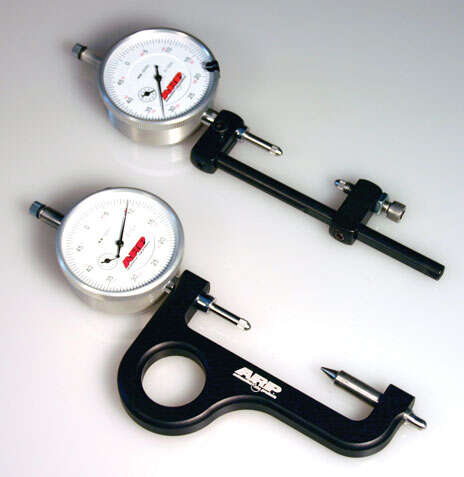Email cannot be empty
Password cannot be empty
Email format error
Email cannot be empty
Email already exists
6-20 characters(letters plus numbers only)
The password is inconsistent
Email format error
Email cannot be empty
Email does not exist
6-20 characters(letters plus numbers only)
The password is inconsistent


ARP Bolts Fastener Installation
The importance of tightening fasteners to their required preload cannot be emphasized enough. If a fastener is not tightened properly, the fastener will not apply the required preload on the application it is being used for and may become susceptible to failure. Conversely, if a fastener is overtightened and stretched too much, it becomes susceptible to failure by exceeding it's maximum yield point. There are three generally accepted methods employed to determine how much tension is exerted on a fastener:
- Using a torque wrench
- Measuring the amount of stretch
- Torque angle (rotating the fastener a predetermined amount)
Of these methods, measuring the amount of stretch of a fastener has been proven to be the most accurate. However, since stretch can only be measured with the use of specialty type gauges or expensive ultra sonic measuring equipment, it is only practical for measuring the stretch on connecting rod bolts and other fasteners, where it is possible to monitor the overall length of a fastener, as it is being tightened. Since most fasteners are installed blind and can't be accessed from both ends to monitor stretch, one will most likely use a torque wrench or other torque angle monitoring device for the majority of assembly work.
It is important to note that in order for a fastener to function properly it must be "stretched" a specific amount. The material's ability to "rebound" like a spring is what provides the clamping force. If you were to simply "finger-tighten" a bolt there would be no preload. However, when you apply torque or rotate a fastener a specific amount and stretch it, you will be applying clamping force. The amount of force or preload you can achieve from any bolt or stud depends on the material being used and its ductility, the heat treat, and the diameter of the fastener. Of course, every fastener has a "yield" point! The yield point or yield strength of a fastener is the point at which the fastener has been overtightened and stretched too much, and will not return to its original manufactured length. As a rule of thumb, if you measure a fastener and it is .001˝ (or more) longer than its original length it has been compromised and must be replaced.
Another factor that must be considered is heat! Heat, primarily in aluminum, is another problem area. Because the thermal expansion rate of aluminum is far greater than that of steel it is possible to stretch a fastener beyond yield as the aluminum expands under heat. An effective way of counteracting material expansion is through producing a more flexible bolt.
We highly recommend using a stretch gauge when installing rod bolts and other fasteners, where it is possible to measure the length of the fastener. It is the most accurate way of measuring preload of any bolt. Simply follow manufacturer's instructions, or use the chart in the our catalog for ARP rod bolts.
When using a stretch gauge it's best to measure the fastener prior to starting and monitor overall length during installation. When the bolt has stretched a specified amount, the correct preload or clamping force has been applied. We recommend that you maintain a chart of all rod bolts and make a note of the fastener length prior to installation and after any disassembly. If there is a permanent increase of .001˝ or more in length, there is a deformation and the bolt should be replaced. You can download a sample rod bolt stretch monitoring chart by clicking here.
There are a number of things to consider when using a torque wrench. The "friction factor" changes from one cycle to the next. That is, friction is at its highest value when the fastener is first tightened. Each subsequent time the fastener is torqued and loosened, the amount of friction lessens. Eventually the friction levels out and becomes fairly consistent for all following repetitions.
- Most importantly - The fastener assembly lubricant
- The condition of the receiving threads
- The surface finish of the fastener
Because of these variables, a phenomenon known as "preload scatter" or preload error occurs. This is basically the difference between the amount of preload achieved on the first installation of the fastener and the amount of preload achieved on subsequent torque/loosen/re-torque cycles. It's not uncommon to see "preload scatter" in the range of 4,000-8,000 pounds between the first and tenth pull on a new fastener depending on the lubricant used.
In addition to the lubricant used, friction is affected by the surface finish of the fastener itself and the condition of the receiving threads. For example, black oxide behaves differently than a polished fastener so it’s important to follow the torque recommendations with each fastener kit. Then there's the very real problem of burrs and debris in the bolt holes that can significantly affect the amount of torque required to achieve the recommended preloads. All bolt holes should be thoroughly cleaned using special "Chaser Taps" to optimize the threads before installation.
It is possible for even the most expensive torque wrenches to lose accuracy over time. Rough use or repeated loosening of fasteners using your torque wrench as a "breaker bar" will exacerbate the loss of accuracy. In fact, ARP field technicians have seen a wide range of torque wrench reading errors as much as 15-30%. This just emphasizes the importance of treating torque wrenches with the utmost of respect and having them checked periodically for accuracy.
Since the amount that a bolt or nut advances on the thread per degree of rotation is determined by the thread pitch, it would appear that any amount of stretch in a given bolt or stud can be accurately predicted be measuring the degrees of turn from the point where the underside of the bolt head or nut face contacts the work surface. Termed the "torque angle" method, this procedure has long been the standard of civil engineering. It has been suggested that torque angle is a relatively simple and valid procedure to use in "blind" installations—where it is not possible to physically measure the actual bolt stretch.
ARP has conducted extensive evaluations of the torque angle method, and concluded that – for high performance engine applications – it is suitable only when calibrated for each installation.
Our investigation has proven that installed stretch is dependent not only on the pitch of the thread and the degree of rotation, but also on the amount of compression of the clamped components, the type of lubrication, the length of the male fastener, and the amount of engaged thread. It's important to note that for the same degree of rotation, the amount of bolt stretch will be critically different between an aluminum or cast iron cylinder head, or when installing a steel main cap on a cast iron or aluminum block. Furthermore, there is a significant difference in stretch between the long and short cylinder head bolts or studs on the same head. The torque angle method can be accurate – but only if each individual application has been previously calibrated by direct measurement of bolt stretch. If you do employ the torque angle method, it's best to begin calibrating rotation from some small measured torque rather than the first point of contact with the work face. To achieve optimum accuracy, always use ARP Ultra-Torque® fastener assembly lubricant whenever possible.
Click here to download a printable rod bolt stretch monitoring chart

